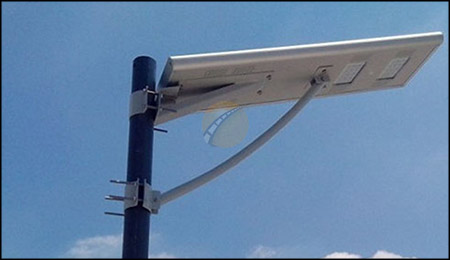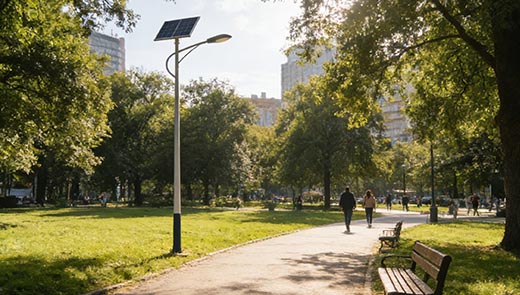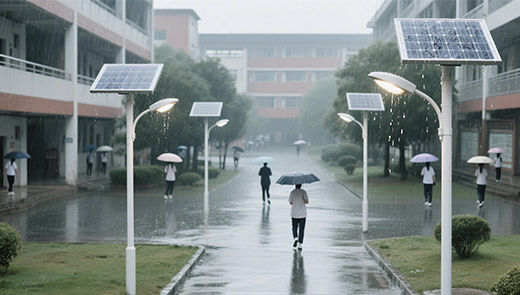Top 5 Reasons Why Sensors on Street Lights are an Important Consideration for a City
In the wave of smart city development, smart street lights equipped with advanced sensor technology are emerging as a new driving force for urban growth. These seemingly ordinary street lights actually hold immense potential to transform urban life. Below, we will delve into the significant role that smart street light sensors play in urban development.
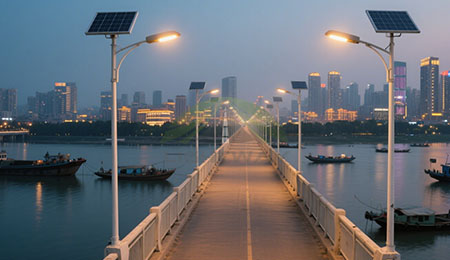
What are Smart Street Lights?
Definition and Core Functions of Smart Street Lights
Smart street lights function as the city's intelligent lighting system, leveraging advanced sensors and computer systems to achieve multiple functions such as energy efficiency, enhanced safety, and environmental protection. These lights can automatically adjust their brightness based on factors like street traffic volume and ambient light intensity. Additionally, smart street lights are closely integrated with Internet of Things (IoT) technology, which enables their intelligent and interconnected capabilities. Furthermore, smart street lights have self-detection capabilities, enabling them to promptly report issues upon detection, significantly improving maintenance efficiency.
Smart Street Lights and Smart City Development
As a key component of smart city development, smart street lights integrate into urban management systems through technological innovation. The sensors they carry continuously collect environmental and traffic data, providing precise insights for urban planning. By leveraging IoT for remote control, they significantly reduce human maintenance costs. Furthermore, smart street lights can interact with other smart urban facilities to further optimize resource utilization, enhance urban management efficiency, and create a more convenient and comfortable living environment for residents.
How Do Smart Street Lights Work?
Smart street lights are interconnected via a network and communicate with a central control system, collectively forming the network infrastructure of a “smart city.” Within this system, street lights can exchange information, and the central control system can remotely manage and control each streetlight.
The micro-sensors built into the street lights are key to their intelligence. These sensors collect a wealth of environmental data: they detect ambient light intensity to adjust streetlight brightness; monitor traffic flow and vehicle speed to provide data for traffic management; and gather information on temperature, humidity, and air quality to support urban environmental monitoring. After analyzing and processing the collected data, the street lights can automatically adjust their operational status and also provide decision-making support for urban managers.
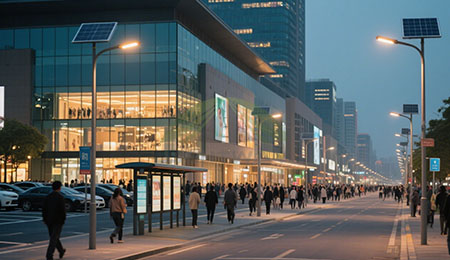
What Types of Sensors Can be Connected to a Smart Streetlight?
Light Sensors
Light sensors, also known as photodiodes or lux sensors, are designed to precisely measure the level of light in the environment. These sensors use the principle of photoelectric conversion to convert the intensity of ambient light into electrical or digital signals, providing critical data for adjusting the brightness of smart street lights.
In practical applications, light sensors enable smart street lights to “perceive day and night.” When the first rays of sunlight hit the ground in the morning, the light sensor detects that the environmental light intensity has reached a certain threshold and immediately sends a signal to the streetlight control system to gradually reduce the brightness of the streetlight, avoiding energy waste. In the evening, as natural light gradually weakens, the sensor adjusts the brightness of the streetlight in response to changes in light intensity.
According to relevant research data, compared to the fixed brightness mode of traditional street lights, smart street lights equipped with light sensors can save approximately 40% of streetlight lighting electricity consumption annually for cities solely through the adaptive brightness adjustment function. Moreover, in complex lighting conditions such as cloudy or overcast days, light sensors can maintain the most appropriate brightness for street lights, ensuring road lighting needs while maximizing energy-saving goals and effectively improving the energy efficiency of the city's lighting system.
Motion Sensors
Motion sensors primarily utilize technologies such as infrared sensing and microwave detection to sensitively detect object movement in their surrounding areas. These sensors feature high sensitivity and rapid response capabilities, enabling them to capture even subtle changes in motion within an extremely short timeframe and swiftly transmit the detected signals to the smart streetlight control system.
In real-world urban street scenarios, motion sensors play a critical role in ensuring safety. For example, in some back alleys with low pedestrian and vehicle traffic, traditional street lights remain fully illuminated even when no one is present, resulting in energy waste. However, smart street lights equipped with motion sensors will instantly activate or increase brightness when detecting pedestrian movement or vehicle activity. Once pedestrians or vehicles leave the monitoring area for a certain period, the street lights will automatically return to low brightness or turn off. This smart lighting mode not only significantly enhances the safety and security of streets when people are present, effectively reducing safety hazards caused by insufficient lighting, but also significantly reduces the power consumption of street lights. According to statistics, after installing motion sensors, the energy consumption of street lights in some areas has decreased by 30% to 50%, while also creating a safer and more energy-efficient nighttime environment for residents.
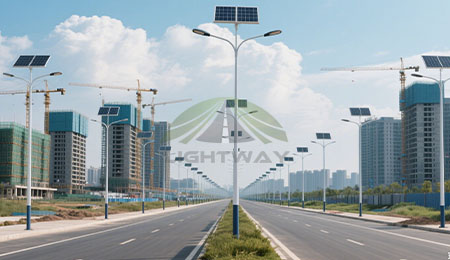
Environmental Sensors
Environmental sensors measure a range of environmental parameters, such as temperature, humidity, air quality, and noise levels. By collecting this real-time environmental data, smart street lights can provide strong support for urban environmental monitoring efforts, helping relevant departments promptly identify pollution issues and providing important reference data for urban planning and development.
Presence Sensors
Presence sensors detect the presence of people or objects within a certain range. In urban areas such as intersections, crosswalks, or parking lots, presence sensors can effectively detect the presence of pedestrians and vehicles, enabling smart street lights to adjust lighting intensity based on actual conditions and further enhance safety in public areas.
Traffic Sensors
Traffic sensors are primarily used to monitor real-time traffic flow, vehicle speed, and congestion levels. Using this data, urban traffic management departments can optimize traffic signal timing, alleviate road congestion, and improve the overall efficiency of urban transportation.
Camera Sensors
Camera sensors can capture images or videos of the surrounding environment. They play a crucial role in multiple fields such as security monitoring, traffic management, and law enforcement. They can be used for routine visual patrols, monitoring traffic conditions, identifying vehicle license plate information, and assisting related work through video analysis technology.
Sound Sensors
Sound sensors, also known as acoustic sensors or microphones, can detect sound intensity and patterns of change. They can be used to monitor urban noise levels, promptly detect sounds associated with traffic accidents or emergencies, and identify abnormal or suspicious sounds in the surrounding area, providing an additional monitoring tool for urban safety management.
Vibration Sensors
Vibration sensors are specifically designed to detect vibration phenomena or seismic activity in the surrounding environment. In urban infrastructure maintenance work, vibration sensors can be used to monitor the structural health of bridges, roads, and other facilities, promptly detect earthquakes or minor vibrations, and also monitor road vibrations caused by traffic, ensuring the stability and safety of urban infrastructure.
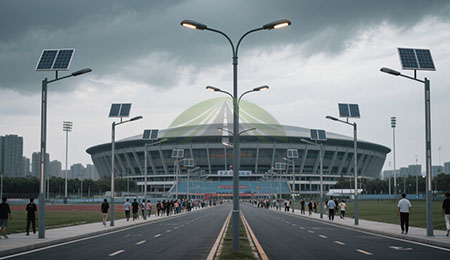
Top 5 Reasons Why Sensors on Street Lights are an Important Consideration for a City
Energy Efficiency
The sensors in smart street lights can detect changes in the surrounding environment in real time and adjust brightness according to actual needs. For example, during late-night hours when there are few pedestrians and vehicles, light sensors and motion sensors work together to reduce the brightness of street lights, thereby minimizing energy consumption. Statistics show that compared to traditional street lights, smart street lights equipped with sensors can save 30% to 60% of energy. This not only helps reduce carbon emissions and promote green development but also saves municipal departments significant electricity costs, thereby lowering urban operational expenses.
Improved Safety
Sensors play a crucial role in enhancing urban traffic safety. Traffic sensors can monitor real-time traffic flow and vehicle speeds, providing data support for optimizing traffic signal timing, effectively alleviating traffic congestion, and reducing the occurrence of traffic accidents. Motion sensors can promptly increase streetlight brightness when pedestrians or vehicles approach, improving road visibility and ensuring nighttime travel safety. Especially in areas with poor lighting conditions, the application of motion sensors significantly enhances residents' sense of security.
Environmental Benefits
Environmental sensors on smart street lights can monitor environmental indicators such as air quality, temperature, and humidity in real time, providing accurate data for urban environmental management. When air quality deteriorates, relevant departments can take timely measures, such as increasing road watering to reduce dust or adjusting industrial production schedules. Through long-term data accumulation and analysis, these sensors can also provide references for urban ecological planning, helping to create a livable urban environment.
Data-Driven Decision Making
The massive amounts of data collected by smart streetlight sensors, after analysis and processing, can provide scientific basis for urban planning and resource allocation. For example, by analyzing traffic flow data, the necessity of road widening or new construction can be determined; based on environmental data, green space planning can be optimized. Real-time, accurate data enables city managers to make more informed decisions, enhancing the scientific rigor and precision of urban management.
Cost Savings
Although the initial procurement and installation costs of smart street lights and sensors are relatively high, the long-term benefits far outweigh the initial investment. Cost savings from energy efficiency, reduced maintenance costs due to automatic fault detection, and decreased social costs from fewer traffic accidents all contribute to significant economic benefits for cities. According to calculations, over a 5- to 10-year usage cycle, the comprehensive cost of a smart streetlight system can be reduced by over 40% compared to a traditional streetlight system.
In smart city development, streetlight sensors collect real-time data on the environment and traffic, enabling intelligent dimming to save 30–60% of energy consumption. They also optimize traffic signals, enhance nighttime lighting safety, and monitor environmental indicators such as air quality, providing data support for urban management. These features drive sustainable urban development from multiple perspectives, including energy conservation, safety, environmental protection, and cost efficiency.

